Color-Coordinated Photocatalysis of the One-Pot Synthesis of Schiff Bases from Benzyl Alcohol and Nitro Compounds Using a Hybrid Magnetic Catalyst
Abstract
:1. Introduction
2. Results and Discussion
2.1. Catalyst Characterization
2.2. Selecting the Optimal Catalyst: Exploring Variations for Enhanced Reaction Performance
2.3. Optimizing Reaction Conditions Using Fe3O4@TiO2 as a Catalyst
2.4. Mechanistic Insights into the Synthesis of Schiff Bases from Nitrobenzene and Benzyl Alcohol
3. Experimental Details
3.1. Catalyst Synthesis
3.2. Catalyst Characterization
3.3. Photocatalytic Activity
4. Conclusions
Supplementary Materials
Author Contributions
Funding
Data Availability Statement
Conflicts of Interest
References
- Fieser, L.F.; Fieser, M. Advanced Organic Chemistry; Reinhold Publishing Corp: New York, NY, USA, 1961. [Google Scholar]
- Schiff, H. A new series of organic diamines. Ann. Chem. Pharm. 1866, 3, 343–370. [Google Scholar]
- Schiff, H. Sopra una nuova serie di basi organiche. Sci. Nat. Econ. Palermo 1866, 2, 201–257. [Google Scholar]
- de Souza, A.O.; Galetti, F.C.S.; Silva, C.L.; Bicalho, B.; Parma, M.M.; Fonseca, S.F.; Marsaioli, A.J.; Trindade, A.C.L.B.; Gil, R.P.F.; Bezerra, F.S.; et al. Antimycobacterial and cytotoxicity activity of synthetic and natural compounds. Quim. Nova 2007, 30, 1563–1566. [Google Scholar] [CrossRef]
- Jarrahpour, A.A.; Motamedifar, M.; Pakshir, K.; Hadi, N.; Zarei, M. Synthesis of Novel Azo Schiff Bases and Their Antibacterial and Antifungal Activities. Molecules 2004, 9, 815–824. [Google Scholar] [CrossRef] [PubMed]
- Yousif, E.; Majeed, A.S.; Al-Sammarrae, K.W.; Salih, N.A.; Salimon, J.; Abdullah, B.M. Metal complexes of Schiff base: Preparation, characterization and antibacterial activity. Arab. J. Chem. 2017, 10, S1639–S1644. [Google Scholar] [CrossRef]
- Boulechfar, C.; Ferkous, H.; Delimi, A.; Djedouani, A.; Kahlouche, A.; Boublia, A.; Darwish, A.S.; Lemaoui, T.; Verma, R.; Benguerba, Y. Schiff bases and their metal Complexes: A review on the history, synthesis, and applications. Inorg. Chem. Commun. 2023, 150, 110451. [Google Scholar] [CrossRef]
- Urbansky, E.T. Carbinolamines and Geminal Diols in Aqueous Environmental Organic Chemistry. J. Chem. Educ. 2000, 77, 1644. [Google Scholar] [CrossRef]
- Saranya, S.; Ramesh, R.; Grzegorz Małecki, J. One-Pot Catalytic Approach for the Selective Aerobic Synthesis of Imines from Alcohols and Amines Using Efficient Arene Diruthenium(II) Catalysts under Mild Conditions. Eur. J. Org. Chem. 2017, 2017, 6726–6733. [Google Scholar] [CrossRef]
- Shiraishi, Y.; Ikeda, M.; Tsukamoto, D.; Tanaka, S.; Hirai, T. One-pot synthesis of imines from alcohols and amines with TiO2 loading Pt nanoparticles under UV irradiation. Chem. Commun. 2011, 47, 4811–4813. [Google Scholar] [CrossRef]
- Selvam, K.; Sakamoto, H.; Shiraishi, Y.; Hirai, T. One-pot synthesis of secondary amines from alcohols and nitroarenes on TiO2 loaded with Pd nanoparticles under UV irradiation. New J. Chem. 2015, 39, 2467–2473. [Google Scholar] [CrossRef]
- Geng, L.; Jian, W.; Jing, P.; Zhang, W.; Yan, W.; Bai, F.-Q.; Liu, G. Crystal phase effect of iron oxides on the aerobic oxidative coupling of alcohols and amines under mild conditions: A combined experimental and theoretical study. J. Catal. 2019, 377, 145–152. [Google Scholar] [CrossRef]
- Sabatier, P. How I Have Been Led to the Direct Hydrogenation Method by Metallic Catalysts. Ind. Eng. Chem. Res. 1926, 18, 1005–1008. [Google Scholar] [CrossRef]
- Sabatier, P. Nobel Lecture: The Method of Direct Hydrogenation by Catalysis; Nobel Lectures, Chemistry 1901–1921; Elsevier Publishing Company: Amsterdam, The Netherlands, 1966. [Google Scholar]
- Marina, N.; Lanterna, A.E.; Scaiano, J.C. Expanding the Color Space in the Two-Color Heterogeneous Photocatalysis of Ullmann C–C Coupling Reactions. ACS Catal. 2018, 8, 7593–7597. [Google Scholar] [CrossRef]
- Anastas, P.; Eghbali, N. Green Chemistry: Principles and Practice. Chem. Soc. Rev. 2010, 39, 301–312. [Google Scholar] [CrossRef]
- Cely-Pinto, M.; Wang, B.; Scaiano, J.C. Photocatalytic Semi-Hydrogenation of Alkynes: A Game of Kinetics, Selectivity and Critical Timing. Nanomaterials 2023, 13, 2390. [Google Scholar] [CrossRef]
- da Silva, D.R.C.; Scaiano, J.C. Exploring the Antibacterial Properties of Lignin-coated Magnetic Nanoparticles Synthesized in a One-pot Process. Photochem. Photobiol. 2023, 99, 706–715. [Google Scholar] [CrossRef]
- Ohtani, B.; Prieto-Mahaney, O.O.; Li, D.; Abe, R. What is Degussa (Evonik) P25? Crystalline composition analysis, reconstruction from isolated pure particles and photocatalytic activity test. J. Photochem. Photobiol. A Chem. 2010, 216, 179–182. [Google Scholar] [CrossRef]
- Holder, C.F.; Schaak, R.E. Tutorial on Powder X-ray Diffraction for Characterizing Nanoscale Materials. ACS Nano 2019, 13, 7359–7365. [Google Scholar] [CrossRef]
- Klein, J.; Kampermann, L.; Mockenhaupt, B.; Behrens, M.; Strunk, J.; Bacher, G. Limitations of the Tauc plot method. Adv. Funct. Mater. 2023, 33, 2304523. [Google Scholar] [CrossRef]
- Chen, X.; Liu, L.; Yu, P.Y.; Mao, S.S. Increasing solar absorption for photocatalysis with black hydrogenated titanium dioxide nanocrystals. Science 2011, 331, 746–750. [Google Scholar] [CrossRef]
- Zhang, Y.; Fulajtárová, K.; Kubů, M.; Mazur, M.; Hronec, M.; Čejka, J. Electronic/steric effects in hydrogenation of nitroarenes over the heterogeneous Pd@BEA and Pd@MWW catalysts. Catal. Today 2020, 345, 39–47. [Google Scholar] [CrossRef]
- Hirao, H.; Ohwada, T. Theoretical study of reactivities in electrophilic aromatic substitution reactions: Reactive hybrid orbital analysis. J. Phys. Chem. A 2003, 107, 2875–2881. [Google Scholar] [CrossRef]
- Tong, J.; Wang, J.; Shen, X.; Zhang, H.; Wang, Y.; Fang, Q.; Chen, L. One-Pot Synthesis of Schiff Bases by Defect-Induced TiO2–x-Catalyzed Tandem Transformation from Alcohols and Nitro Compounds. Inorg. Chem. 2021, 60, 10715–10721. [Google Scholar] [CrossRef] [PubMed]
- Hirakawa, H.; Katayama, M.; Shiraishi, Y.; Sakamoto, H.; Wang, K.; Ohtani, B.; Ichikawa, S.; Tanaka, S.; Hirai, T. One-pot synthesis of imines from nitroaromatics and alcohols by tandem photocatalytic and catalytic reactions on degussa (Evonik) P25 titanium dioxide. ACS Appl. Mater. Interfaces 2015, 7, 3797–3806. [Google Scholar] [CrossRef] [PubMed]
- Cano, R.; Ramón, D.J.; Yus, M. Impregnated ruthenium on magnetite as a recyclable catalyst for the N-alkylation of amines, sulfonamides, sulfinamides, and nitroarenes using alcohols as electrophiles by a hydrogen autotransfer process. J. Org. Chem. 2011, 76, 5547–5557. [Google Scholar] [CrossRef]
- Zanardi, A.; Mata, J.A.; Peris, E. One-Pot Preparation of Imines from Nitroarenes by a Tandem Process with an Ir–Pd Heterodimetallic Catalyst. Chem. Eur. J. 2010, 16, 10502–10506. [Google Scholar] [CrossRef]
- Wu, J.; Darcel, C. Iron-catalyzed hydrogen transfer reduction of nitroarenes with alcohols: Synthesis of imines and AZA heterocycles. J. Org. Chem. 2020, 86, 1023–1036. [Google Scholar] [CrossRef]
- Pérez, J.M.; Cano, R.; Yus, M.; Ramón, D.J. Straightforward Synthesis of Aromatic Imines from Alcohols and Amines or Nitroarenes Using an Impregnated Copper Catalyst. Eur. J. Org. Chem. 2012, 24, 4548–4554. [Google Scholar] [CrossRef]
- Zou, G.; Cao, R.; Cui, C.; Luo, Y.; Huang, C.; Cui, X.; Wang, Z.; Song, Y. Photocatalytic one-pot alkylation of nitrobenzene with benzyl alcohol for the precise synthesis of N-benzylideneaniline over F-doped Bi2MoO6 nanosheets. Catal. Sci. Technol. 2023, 13, 3916–3926. [Google Scholar] [CrossRef]
- Higashimoto, S.; Nakai, Y.; Azuma, M.; Takahashi, M.; Sakata, Y. One-pot synthesis of imine from benzyl alcohol and nitrobenzene on visible-light responsive CdS–TiO2 photocatalysts. RSC Adv. 2014, 4, 37662–37668. [Google Scholar] [CrossRef]
- Liu, D.; Yang, P.; Zhang, H.; Liu, M.; Zhang, W.; Xu, D.; Gao, J. Direct reductive coupling of nitroarenes and alcohols catalysed by Co-N-C/CNT@AC. Green Chem. 2019, 21, 2129–2137. [Google Scholar] [CrossRef]
- Ye, X.; Chen, Y.; Wu, Y.; Zhang, X.; Wang, X.; Chen, S. Constructing a system for effective utilization of photogenerated electrons and holes: Photocatalytic selective transformation of aromatic alcohols to aromatic aldehydes and hydrogen evolution over Zn3In2S6 photocatalysts. Appl. Catal. B Environ. 2019, 242, 302–311. [Google Scholar] [CrossRef]
- Gawargy, T.A.; Costa, P.; Lanterna, A.E.; Scaiano, J.C. Photochemical benzylic radical arylation promoted by supported Pd nanostructures. Org. Biomol. Chem. 2020, 18, 6047–6052. [Google Scholar] [CrossRef] [PubMed]
- Zhan, C.; Wang, Q.-X.; Yi, J.; Chen, L.; Wu, D.-Y.; Wang, Y.; Xie, Z.-X.; Moskovits, M.; Tian, Z.-Q. Plasmonic nanoreactors regulating selective oxidation by energetic electrons and nanoconfined thermal fields. Sci. Adv. 2021, 7, eabf0962. [Google Scholar] [CrossRef] [PubMed]
- Ling, C.; Ye, X.; Zhang, J.; Zhang, J.; Zhang, S.; Meng, S.; Fu, X.; Chen, S. Solvothermal synthesis of CdIn2S4 photocatalyst for selective photosynthesis of organic aromatic compounds under visible light. Sci. Rep. 2017, 7, 27. [Google Scholar] [CrossRef]
- Dai, X.; Xie, M.; Meng, S.; Fu, X.; Chen, S. Coupled systems for selective oxidation of aromatic alcohols to aldehydes and reduction of nitrobenzene into aniline using CdS/g-C3N4 photocatalyst under visible light irradiation. Appl. Catal. B Environ. 2014, 158–159, 382–390. [Google Scholar] [CrossRef]
- Lee, S.G.; Kang, M.J.; Park, M.; Kim, K.-j.; Lee, H.; Kim, H.S. Selective photocatalytic conversion of benzyl alcohol to benzaldehyde or deoxybenzoin over ion-exchanged CdS. Appl. Catal. B Environ. 2022, 304, 120967. [Google Scholar] [CrossRef]
- Ning, X.; Meng, S.; Fu, X.; Ye, X.; Chen, S. Efficient utilization of photogenerated electrons and holes for photocatalytic selective organic syntheses in one reaction system using a narrow band gap CdS photocatalyst. Green Chem. 2016, 18, 3628–3639. [Google Scholar] [CrossRef]
- Hainer, A.S.; Hodgins, J.S.; Sandre, V.; Vallieres, M.; Lanterna, A.E.; Scaiano, J.C. Photocatalytic Hydrogen Generation Using Metal-Decorated TiO2: Sacrificial Donors vs True Water Splitting. ACS Energy Lett. 2018, 3, 542–545. [Google Scholar] [CrossRef]
- Xu, L.; Meng, L.; Zhang, X.; Mei, X.; Guo, X.; Li, W.; Wang, P.; Gan, L. Promoting Fe3+/Fe2+ cycling under visible light by synergistic interactions between P25 and small amount of Fenton reagents. J. Hazard. Mater. 2019, 379, 120795. [Google Scholar] [CrossRef]
- Aguinaco, A.; Mánuel, J.M.; Blanco, E.; Domínguez, M.; Litrán, R.; Delgado, J.J.; Ramírez-del-Solar, M. Fe3O4-TiO2 Thin Films in Solar Photocatalytic Processes. Materials 2022, 15, 6718. [Google Scholar] [CrossRef] [PubMed]
- Scaiano, J.C.; Yaghmaei, M.; da Silva, D.R.C.; Rutajoga, N.; Currie, S.; Li, Y.; Vallieres, M.; Joshi, N.; Wang, B. Visible light photocatalytic water remediation strategies using a novel black TiO2 based material optimized for in-flow applications. ChemRxiv 2023. [Google Scholar] [CrossRef]
- Liu, H.; Di Valentin, C. Band Gap in Magnetite above Verwey Temperature Induced by Symmetry Breaking. J. Phys. Chem. C 2017, 121, 25736–25742. [Google Scholar] [CrossRef] [PubMed]
- Peng, L.; Xie, T.; Lu, Y.; Fan, H.; Wang, D. Synthesis, photoelectric properties and photocatalytic activity of the Fe2O3/TiO2 heterogeneous photocatalysts. Phys. Chem. Chem. Phys. 2010, 12, 8033–8041. [Google Scholar] [CrossRef] [PubMed]
- Bahnemann, D.W.; Hilgendorff, M.; Memming, R. Charge Carrier Dynamics at TiO2 Particles: Reactivity of Free and Trapped Holes. J. Phys. Chem. B 1997, 101, 4265–4275. [Google Scholar] [CrossRef]
- Nolan, M. Electronic coupling in iron oxide-modified TiO2 leads to a reduced band gap and charge separation for visible light active photocatalysis. Phys. Chem. Chem. Phys. 2011, 13, 18194–18199. [Google Scholar] [CrossRef] [PubMed]
- Ye, X.; Chen, Y.; Ling, C.; Ding, R.; Wang, X.; Zhang, X.; Chen, S. One-Pot Synthesis of Schiff Base Compounds via Photocatalytic Reaction in the Coupled System of Aromatic Alcohols and Nitrobenzene Using CdIn2S4 Photocatalyst. Dalton Trans. 2018, 47, 10915–10924. [Google Scholar] [CrossRef]
- Wu, Y.; Ye, X.; Zhang, S.; Meng, S.; Fu, X.; Wang, X.; Zhang, X.; Chen, S. Photocatalytic Synthesis of Schiff Base Compounds in the Coupled System of Aromatic Alcohols and Nitrobenzene Using CdXZn1−XS Photocatalysts. J. Catal. 2018, 359, 151–160. [Google Scholar] [CrossRef]



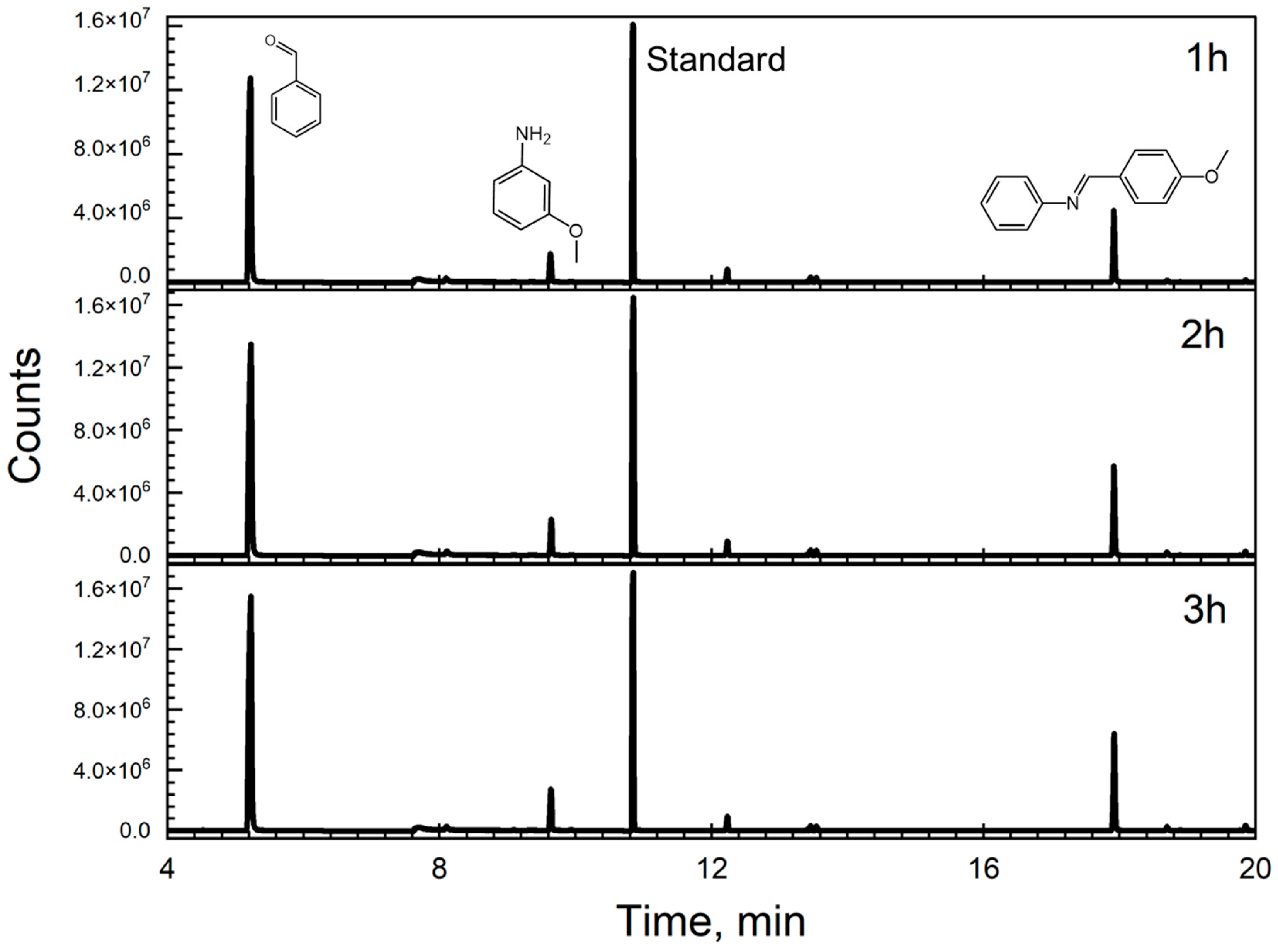
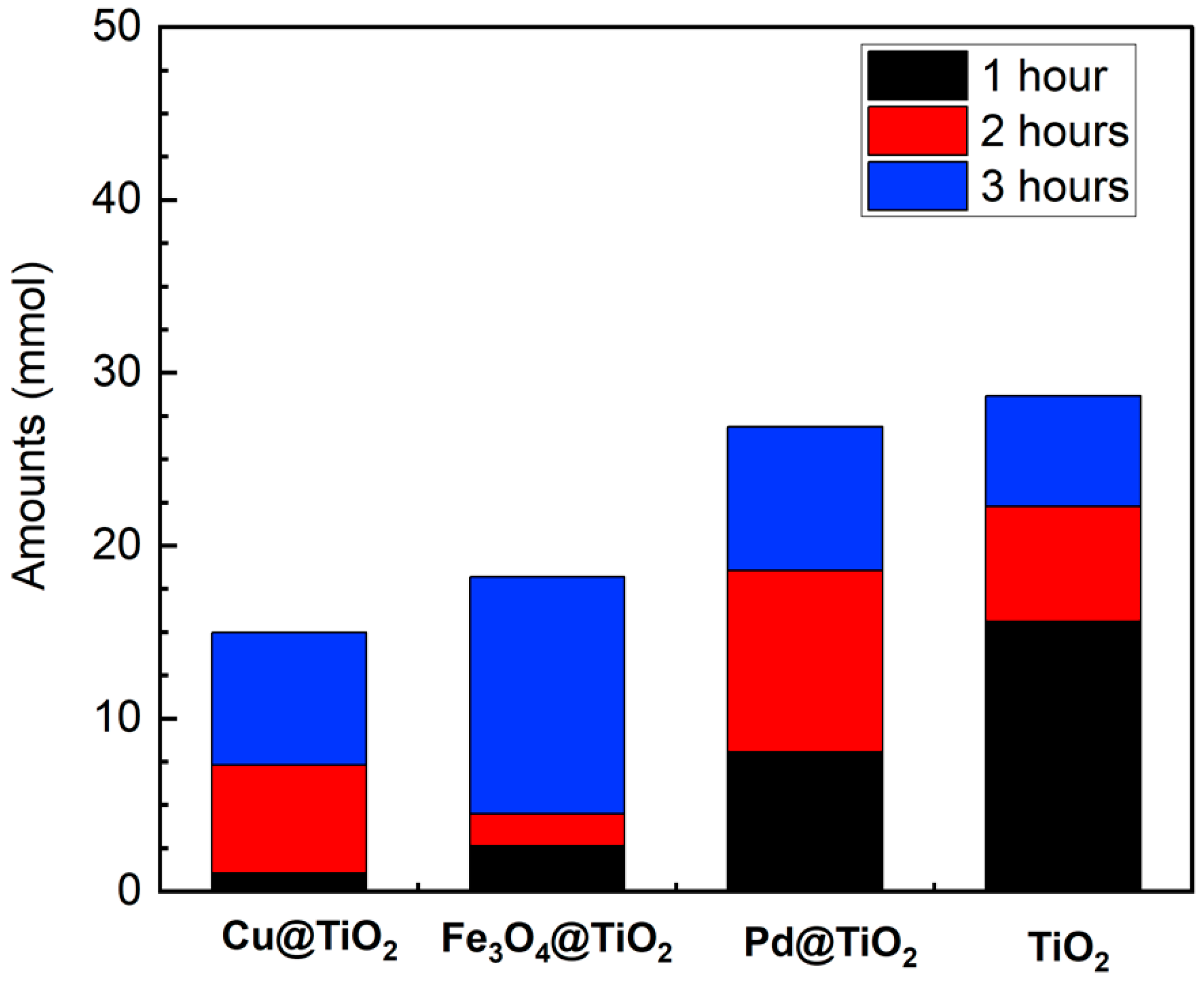

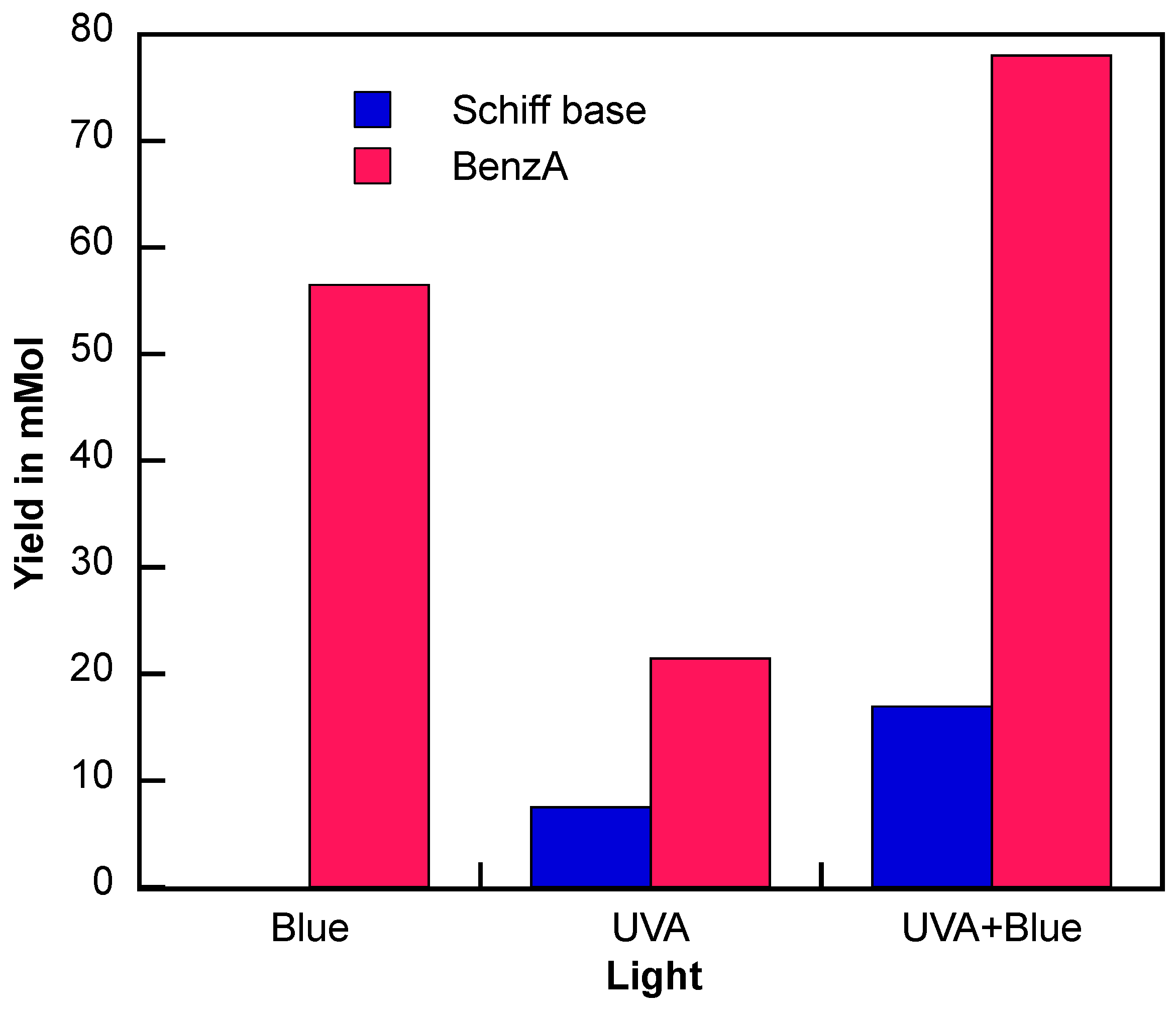
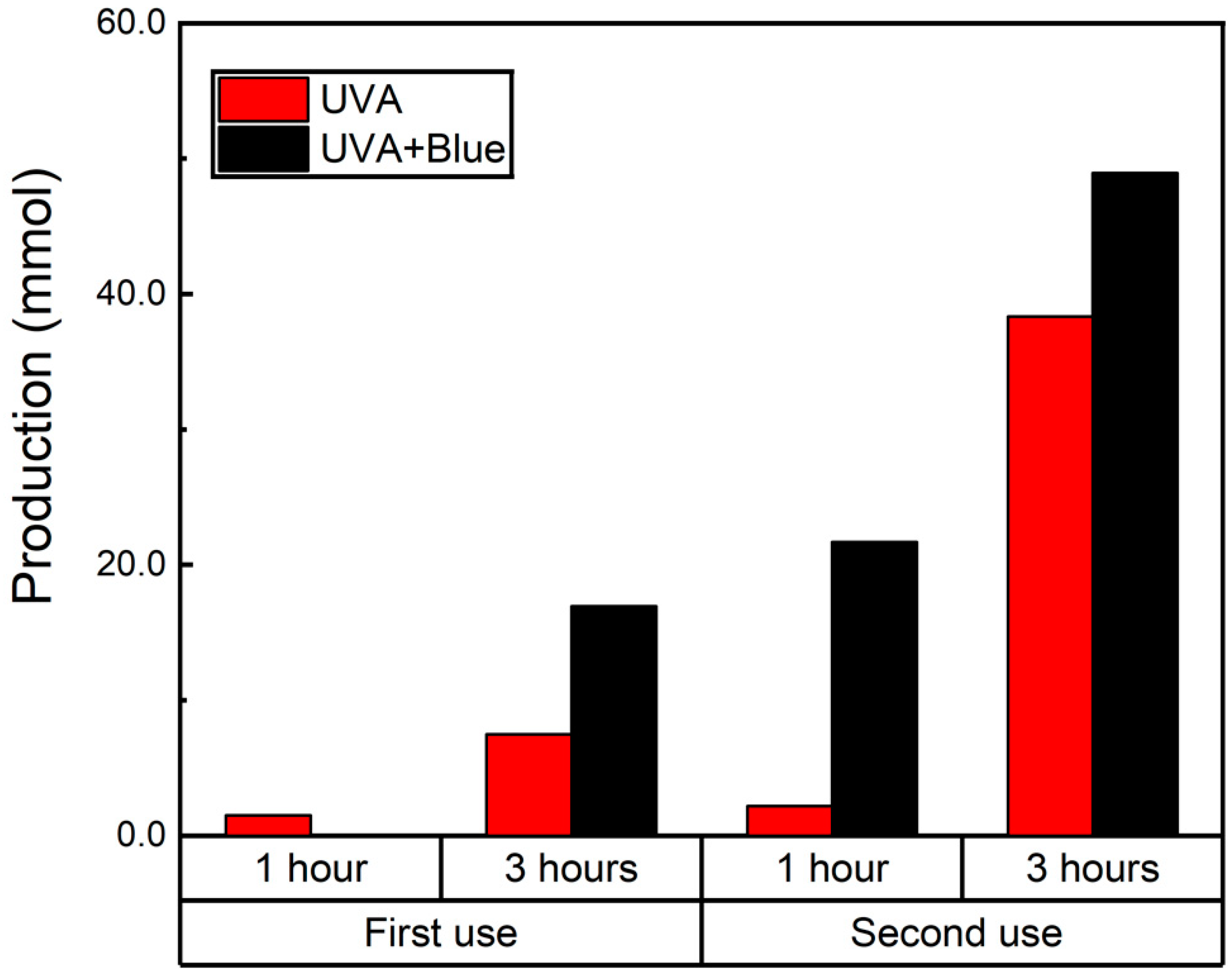
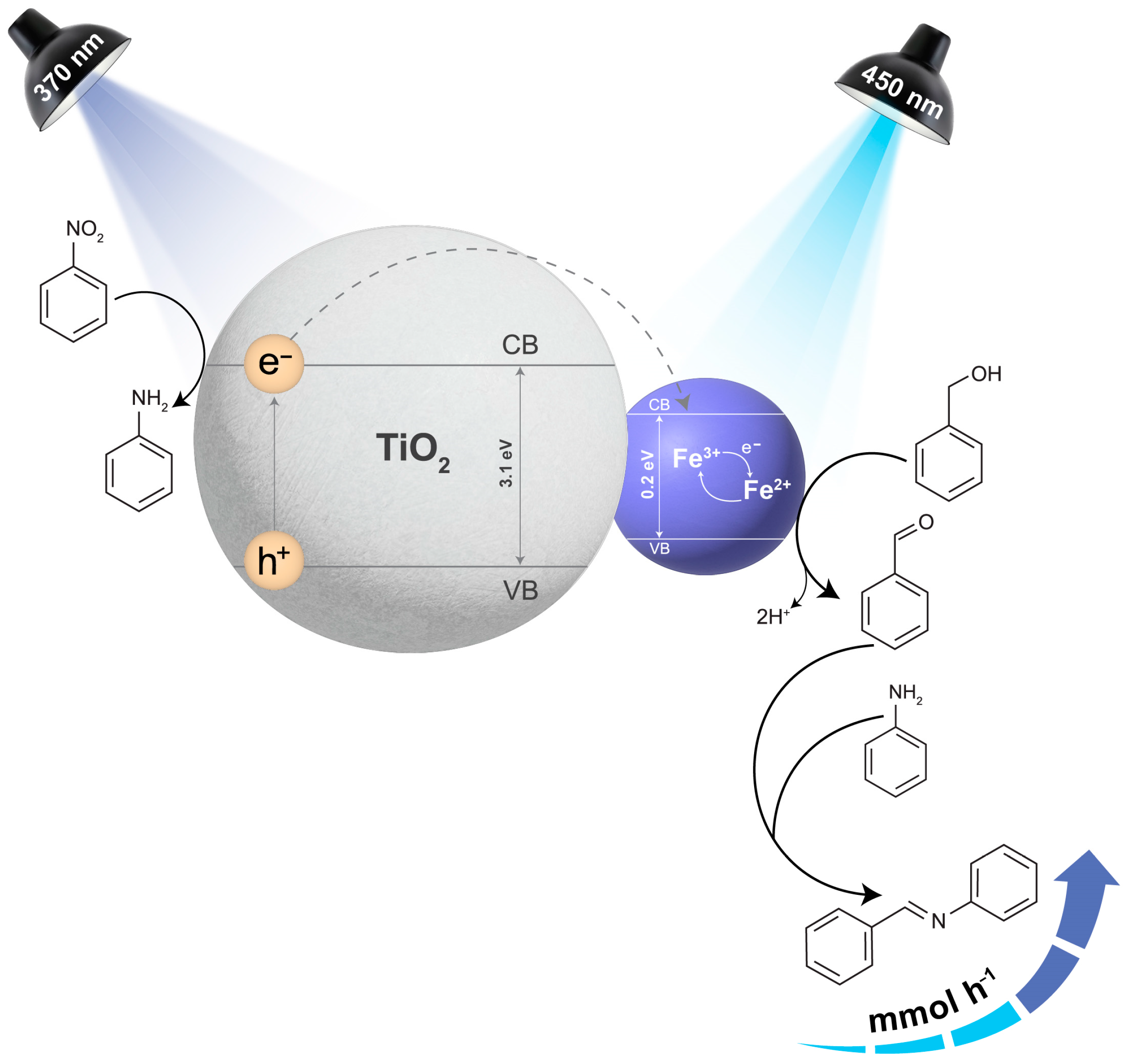
| Material | Metal Loading (%) |
|---|---|
| Fe3O4@TiO2 | 12 wt% (±0.93) Fe |
| Pd@TiO2 | 2.0 wt% (±0.85) Pd |
| Cu@TiO2 | 3.0 wt% (±0.94) Cu |
| Entry | Catalyst | Light Source | Irradiance (mW·cm−2) | Time (h) | Yield Schiff Base (%) | Production Rate (mmol h−1) |
|---|---|---|---|---|---|---|
| 1 | Fe3O4@TiO2 | 370 nm | 13.5 | 6 | 41.6 | 6.9 |
| 2 | TiO2 | 370 nm | 13.5 | 6 | 36.7 | 6.1 |
| 3 | Fe3O4@TiO2 | 370 nm | 13.5 | 20 | >99 | 4.95 |
| 4 | Fe3O4@TiO2 | 370 nm | 5.3 | 3 | 1.9 | 0.63 |
| 5 | Fe3O4@TiO2 | 450 nm | 13.0 | 3 | ND a | ND |
| 6 | Fe3O4@TiO2 | None | NA | 3 | ND | ND |
| 7 | Fe3O4@TiO2 | 370 nm | 3.5 | 3 b | 44.3 | 14.76 |
Disclaimer/Publisher’s Note: The statements, opinions and data contained in all publications are solely those of the individual author(s) and contributor(s) and not of MDPI and/or the editor(s). MDPI and/or the editor(s) disclaim responsibility for any injury to people or property resulting from any ideas, methods, instructions or products referred to in the content. |
© 2024 by the authors. Licensee MDPI, Basel, Switzerland. This article is an open access article distributed under the terms and conditions of the Creative Commons Attribution (CC BY) license (https://creativecommons.org/licenses/by/4.0/).
Share and Cite
Regis Correa da Silva, D.; Cely-Pinto, M.; Scaiano, J.C. Color-Coordinated Photocatalysis of the One-Pot Synthesis of Schiff Bases from Benzyl Alcohol and Nitro Compounds Using a Hybrid Magnetic Catalyst. Catalysts 2024, 14, 612. https://doi.org/10.3390/catal14090612
Regis Correa da Silva D, Cely-Pinto M, Scaiano JC. Color-Coordinated Photocatalysis of the One-Pot Synthesis of Schiff Bases from Benzyl Alcohol and Nitro Compounds Using a Hybrid Magnetic Catalyst. Catalysts. 2024; 14(9):612. https://doi.org/10.3390/catal14090612
Chicago/Turabian StyleRegis Correa da Silva, Daliane, Melissa Cely-Pinto, and Juan C. Scaiano. 2024. "Color-Coordinated Photocatalysis of the One-Pot Synthesis of Schiff Bases from Benzyl Alcohol and Nitro Compounds Using a Hybrid Magnetic Catalyst" Catalysts 14, no. 9: 612. https://doi.org/10.3390/catal14090612






